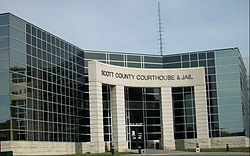Scott County | |
|---|---|
 | |
 Location within the U.S. state of Iowa | |
 Iowa's location within the U.S. | |
| Coordinates: 41°38′09″N90°38′02″W / 41.635833333333°N 90.633888888889°W | |
| Country | |
| State | |
| Founded | 1837 |
| Named after | Winfield Scott |
| Seat | Davenport |
| Largest city | Davenport |
| Area | |
• Total | 468 sq mi (1,210 km2) |
| • Land | 458 sq mi (1,190 km2) |
| • Water | 10 sq mi (26 km2) 2.2% |
| Population (2020) | |
• Total | 174,669 |
| • Density | 381/sq mi (147/km2) |
| Time zone | UTC−6 (Central) |
| • Summer (DST) | UTC−5 (CDT) |
| Congressional district | 1st |
| Website | www |
Scott County is a county located in the U.S. state of Iowa. As of the 2020 census, the population was 174,669, [1] making it the third-most populous county in Iowa. The county seat is Davenport.
Contents
- History
- Geography
- Major highways
- Transit
- Adjacent counties
- Demographics
- 2020 census
- 2010 census
- 2000 census
- Communities
- Cities
- Census-designated places
- Other unincorporated communities
- Townships
- Population ranking
- Politics
- Education
- Higher education institutions
- See also
- Notes
- References
- External links
Scott County is included in the Davenport–Moline-Rock Island, IA–IL Metropolitan Statistical Area. [2]





